#Reindeer in Murmansk
Explore tagged Tumblr posts
Text

Yevgeny Khaldei Reindeer in Murmansk, Russia, 1941
35 notes
·
View notes
Text

Reindeer in Murmansk 1941
27 notes
·
View notes
Text
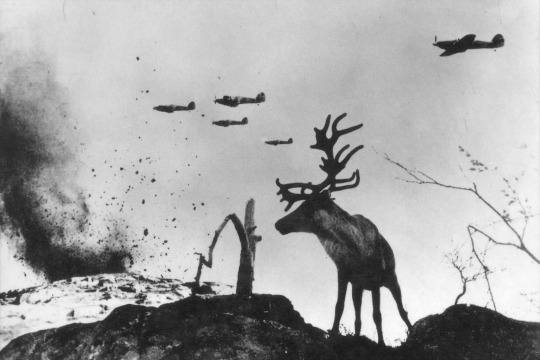
THE COMPOSITE PHOTOGRAPHY OF THE EASTERN FRONT -- MAN VERSUS NATURE.
PIC INFO: Resolution at 1600x1067 -- Spotlight on a composite photograph titled "Reindeer Yasha beyond the Arctic Circle," World War II, Murmansk Area, USSR, c. 1941. 📸: Yevgeny Khaldei.
MINI OVERVIEW: "World War II planes bomb a hillside while a shellshocked reindeer looks on. The stark interface between the killing machines of man and the natural grandeur and beauty of the reindeer was not "natural."
Yevgeny Khaldei, the famous Soviet photographer who took this photo, frequently staged or manipulated his photos to (as he defended the practice) enhance and strengthen the “truth” of the visual moment."
-- RARE HISTORICAL PHOTOS, "Reindeer in Murmansk," 1941
Source: https://rarehistoricalphotos.com/reindeer-murmansk-1941.
#Eastern Front#USSR#World War II#World War 2#War photography#1940s#1941#Soviet Union#Yevgeny Khaldei#Composite photography#Photography#Soviet Russia#Reindeer#Arctic Circle#40s#Murmansk#U.S.S.R.#Animals#Nature#Russia#The Great Patriotic War#WW2#The Great Patriotic War 1941-1945#Great Patriotic War
47 notes
·
View notes
Text

Reindeer in Murmansk 1941.
Photo by Yevgeny Khaldei
13 notes
·
View notes
Text
Experience the Magic of Aurora Lights with a Russia Tour

Russia, a land of unparalleled beauty and rich cultural heritage, offers one of the most mesmerizing natural spectacles—the enchanting Aurora Borealis. An Aurora Light Russia Tour promises travelers an unforgettable experience, blending the mystique of nature's light show with the captivating charm of Russia’s northern landscapes. If you're seeking a unique adventure, Aurora Light Russia Tour Packages offer the perfect combination of thrill and serenity.
Witnessing the Aurora Borealis is a dream for many. This awe-inspiring natural phenomenon, often referred to as the Northern Lights, lights up the skies with vibrant hues of green, pink, and purple. An Aurora Light Russia Trip allows you to immerse yourself in this magical display in some of the best viewing locations in the Arctic regions of Russia, such as Murmansk and Teriberka. These areas, with their unspoiled wilderness and minimal light pollution, provide the perfect setting for capturing the dance of the auroras in all their glory.
In addition to the celestial show, the Russia Tour Packages curated by European Konnect allow travelers to explore Russia’s rich history and culture. While in the Arctic region, enjoy the unique Sami culture, reindeer sledding, and snowmobile adventures that complement your quest for the Aurora Borealis. This blend of adventure and cultural immersion makes an Aurora Light Russia Tour a wholesome experience that caters to both nature enthusiasts and culture seekers alike.
For those looking to extend their journey, Russia Tourism Packages offer the flexibility to explore other parts of the country. From the majestic Kremlin in Moscow to the picturesque canals of St. Petersburg, Russia has no shortage of iconic landmarks and historical treasures. The contrast between the vibrant urban landscapes and the serene Arctic wilderness is sure to leave every traveler spellbound.
An Aurora Light Russia Trip is not just about chasing the Northern Lights; it’s about embracing the tranquility of Russia’s Arctic nights, creating memories around warm bonfires, and marveling at a sky painted by nature’s hand. European Konnect ensures that each tour is meticulously planned, offering a seamless experience that caters to both solo adventurers and families.
Whether you are embarking on your first Northern Lights adventure or are a seasoned traveler, the Aurora Light Russia Tour Packages provide something for everyone. With a focus on comfort, safety, and authentic experiences, these packages are designed to make your dream of witnessing the Aurora Borealis come true.
Let Russia’s Arctic region captivate your soul with its ethereal beauty. Book your Russia Tourism Packages now and get ready to create stories under the shimmering auroras. With European Konnect as your travel partner, you’re in for a journey that transcends the ordinary and ventures into the extraordinary.
0 notes
Text
Tour Packages Murmansk - SALVIA TRAVELS Northern lights. Once in a lifetime experience
Salvia Travels offers a wide variety of tour packages to see the Northern Lights in Murmansk, Russia.
These words are not enough to describe the feeling of seeing the Aurora Borealis. It is an experience that you will never forget. And what better place to see the Northern Lights than Murmansk, Russia? SALVIA TRAVELS offers tour packages that will take you to some of the best places to see the Northern Lights in Murmansk. We also provide a variety of other activities such as dog sledding, visiting reindeer farms, and snowmobiling. So whether you are looking for an adventure or a relaxing vacation, we have a package for you! For More Information Visit here- salvia visa facilitation services Contact No - +91-9810063981 Mail- [email protected], [email protected] Website - https://salviatravelsindia.com/tour-packages-murmansk/

1 note
·
View note
Photo
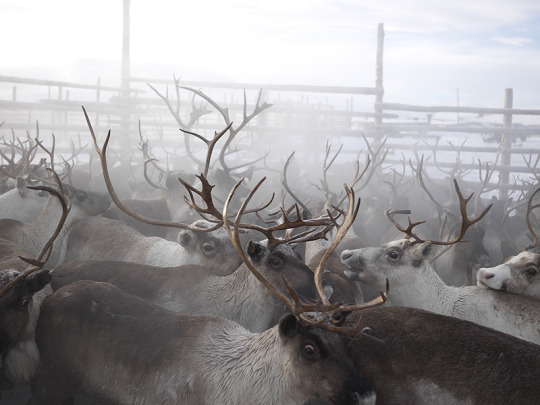

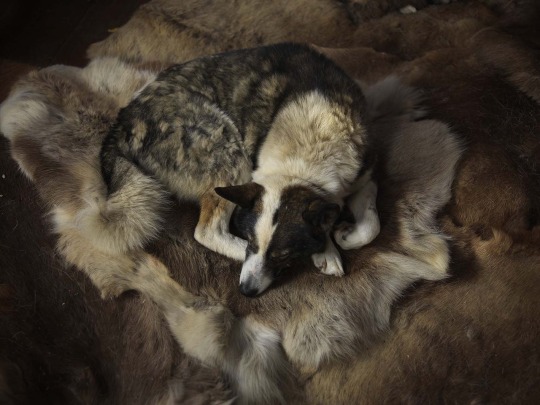
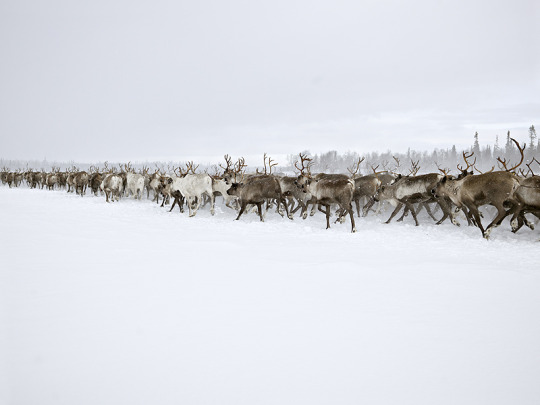
Reindeer herding in the Kola Peninsula, Céline Clanet.
#animal photography#celine clanet#french photography#russia#murmansk oblast#russian photography#sami people#reindeer#dogs#my post#people#animals
3K notes
·
View notes
Photo

Planes bomb a hillside while a reindeer looks on (Murmansk Oblast, Russia, WW2). This is actually a composite image, with the planes and exploding bomb added later.
The photo was taken by Yevgeny Khaldei, who often staged or manipulated his photos to “enhance and strengthen the 'truth' of the visual moment”. According to Khaldei:
“During the bombings, a reindeer came out of the tundra. He wanted to be with people. They built him a shed to live in, and gave him a name, Yasha. Every time the alarm sounded, he ran to be with the soldiers–he didn’t want to be alone. During one of the air raids, I took this shot. In 1944, when the battle for Murmansk was over, the soldiers didn’t know what to do with him. They loaded him into a truck and took him back to the tundra, thinking he would join the other deer. But he couldn’t understand what was happening. He ran after the truck as long as he could.”
#history#military history#journalism#photography#animals#ww2#operation silver fox#ussr#russia#murmansk oblast#yevgeny khaldei#reindeer#air raids
15 notes
·
View notes
Text
In Russia, Indigenous land defenders face intimidation and exile
Pressure on communities comes as regional elites and big companies look to develop resource-rich Indigenous lands.
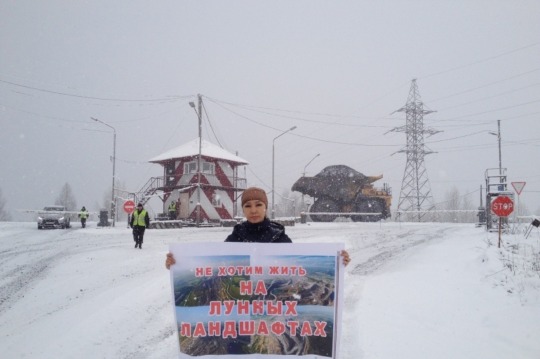
Yana Tannagasheva, an Indigenous Shor activist who protested against coal mining on her people's ancestral lands in western Siberia, holds a banner that says: 'We don't want to live in moonscapes' [Courtesy: Nelly Slupachik]
By Mansur Mirovalev
Published On 23 Jan 2022
The police officers could have planted drugs in his backpack, Andrey Danilov says.
So he refused to show its contents to the officers who did not identify themselves or say why they approached him in late August 2021 in the Arctic town of Monchegorsk in northwestern Russia.
Drugs planted by police have become a routine part of a crackdown on liberal opposition, independent journalists and human rights activists.
But Danilov is none of the above.
He is a community leader of some 1,600 Saami living in Russia’s Murmansk region near Norway. They are a fraction of the Saami Indigenous nation that primarily lives in Arctic Scandinavia in the region which the Saami call Sapmi, a place also known as Lapland and advertised to tourists as Santa’s home.
Danilov says the search and subsequent detention were part of perennial official pressure on him, payback for leading a campaign against platinum and palladium mining on Saami lands, and for his victory in July in the Constitutional Courtwhich ruled that unlicensed hunting is the birthright of any Indigenous person as part of their traditional way of life.
Russian law suggests that only Indigenous people living in the wilderness and not in urban centres can hunt without a licence, but Danilov, who lives in the town of Severstal, proved that hunting is part of his culture and beliefs.
Danilov was released hours after the news of his detention reached other activists and independent media. But he knows the pressure is far from over.
“Their main goal is to either push me to flee abroad or to force me to shut up,” Danilov, 51, who is head of the grassroots group the Saami Heritage and Development Foundation, tells Al Jazeera.

In early November, 116 human and Indigenous rights groups and dozens of individuals signed an open letterto Russian President Vladimir Putin detailing the persecution of Danilov and other Indigenous activists across Russia. So far, the Kremlin has not replied.
A truck loaded with coal in the town of Kazas, western Siberia, where the Indigenous Shor people fought against the development of new coal mines [Courtesy of Nelly Slupachik]
A gold rush
Most of Russia’s Indigenous nations, as Indigenous groups are referred to in Russia, still rely on hunting and gathering, fishing and reindeer husbandry. But their lands – like those of other Indigenous communities from Papua New Guinea to Alaska – are treasure troves of fossil fuels, gold and other minerals as well as timber, game and fish.
And they are falling victim to a nationwide gold rush for these resources.
A warming Arctic, modern technologies and growing demand are opening up deposits previously deemed unavailable or too expensive to develop. As resources open up, the Kremlin, regional elites and big businesses including those owned by Putin’s former colleagues and neighbours or Kremlin-friendly oligarchs are eager to develop them.
“The development should be conducted in accordance with high ecological standards and with respect to the specifics of the local populations’ traditional lifestyle,” Russian Foreign Minister Sergey Lavrov said in May addressing the Arctic Council, an intergovernmental forum of eight countries including Russia.
But the development disrupts migration routes of wild animals or deer herds, spawning routes of fish, and destroys nesting grounds, sacred sites and burial grounds, Indigenous activists and observers say.
“For the Indigenous nations, their land is something sacred, they can’t live without the land, the fish, the forest, the tundra,” Danilov says.
Meanwhile, the developers increasingly ignore the United Nations Declaration on the Rights of Indigenous Peoples (UNDRIP) that prescribe their informed collective consent before any use of their land.
There is a scramble to develop the land for its resources, Danilov says. “And the Indigenous nations have simply become pawns in the big politics.”
As commercial interest grows, Indigenous activists fight the encroachment with the very limited means they have – protest rallies, lawsuits mostly lost in Kremlin-controlled courts, social media posts and appeals to independent media, rights groups and the UN.
In return, the activists face harassment, intimidation, arrests and surveillance by police and intelligence services, smear campaigns, destruction of property, accusations of “separatism” and exile, according to rights groups, the UN, independent media and court papers.
“Those who see the injustice towards their people, their nations, who simply discuss it, automatically get listed as people’s enemies,” Pavel Sulyandziga, an exiled community leader of the Udege, an Indigenous nation of some 1,500 that lives near the Chinese border, tells Al Jazeera.

Members of the Udege Indigenous nation stand next to a large plush toy of a Siberian tiger, a protected animal [Courtesy of Pavel Sulyandziga]
Tigers and jade
Sulyandziga, 59, is a bearded, bespectacled former maths teacher who rose to become one of Russia’s top Indigenous rights officials in several government bodies and Indigenous groups in the 1990s.
His community’s land in Russia’s Far East is home to the Siberian tiger, the world’s largest cat. In the early 2000s, the black market price for one poached animal – whose body parts and even faeces are prized in Chinese medicine – exceeded $50,000, and they numbered several hundred.
But Putin took a shine to them and made headlines in 2008 after shooting a tigress with a tranquiliser to place a tracking device around her neck and creating a national reserve for the felines in the cedar forests where the Udege live, hunt and fish.
The reserve became a boon to the community that enjoys an uninterrupted electricity supply for the first time in their history and no longer has to worry about illegal logging and clandestine cannabis plantations because the preserve is protected by federal officials.
“They’ve never been better off,” Sulyandziga says.
But not him.
Pressure on Sulyandziga began after he organised public hearings on pressure on an Evenki Indigenous community that developed a jade mine on their ancestral lands in the taiga forest of the southeastern Buryatia region near Mongolia. Jade has been prized in China for millennia, and by 2010, the price of the semitranslucent stone exceeded that of gold.
In 2012, the mine was taken over by the Rostec state-run corporation focusing on defence and hi-tech.
That year, criminal charges were brought against community leaders, leading to confiscation of jade and land, activists say.
“Within months, the community was disbanded, some of its members were jailed, some were forced to leave Russia,” Dmitry Berezhkov, an Indigenous rights activist from the Itelmen nation that lives on the Pacific Peninsula of Kamchatka, tells Al Jazeera.
Since then, the community has faced expulsion from their land, community leaders said in a video appeal to Putin in 2019.
Sulyandziga claimed he was accused by state officials of “separatism”, “espionage” and embezzlement. His sons and brother, also an Indigenous rights activist, faced pressure too.
In 2016, Sulyandziga left for New York to deliver a speech at a UN session about Russia’s Indigenous rights situation. He says he never returned because a high-ranking security official told him that intelligence services planned to kill him and present his death as “suicide”.
Today he is an associate researcher at Bowdoin College in Maine and heads the Batani Foundation, an Indigenous rights group.
He says that since he left, pressure on Indigenous communities “rose dramatically”.
“If in the past intelligence services tried to at least pretend to make their actions look legitimate, now they simply don’t need to do that,” he says. “If in the past they tried to pressure leaders, now they pressure everyone who simply tries to tell the truth.”
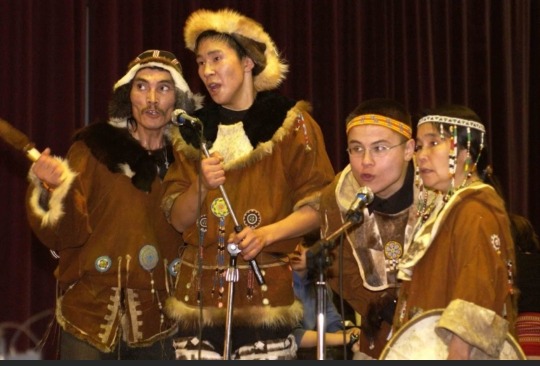
Activist Dmitry Berezhkov, second from right, of the Itelmen nation at the 2002 Alaska Federation of Natives conference now lives in Norway where he was granted asylum [Courtesy of Dmitry Berezhkov]
Living on the edge
Russia’s 46 Indigenous groups are known officially as the “small nations of the North, Siberia and the Far East”.
They amount to less than 300,000 people, or 0.2 percent of Russia’s population of 144 million, but live in autonomies that are often larger than some European nations.
Some of these autonomies live on land covered by permafrost and tundra; some are nestled in the world’s largest forest, the Siberian taiga.
Their remoteness from urban centres and agricultural areas saved them from assimilation – even though since the Soviet era, the children of taiga nomads and hunters were often educated in Russian-language boarding schools where they were punished for speaking their mother tongues.
Putin has lauded the “small nations” for making Russia a diverse, multiethnic country and has on many occasions said the Kremlin promotes their legacy by funding the festivals of their culture and music, documentaries and cartoons based on their folklore.
“The unique diversity of [Russia’s] traditions and tongues is our common, priceless property that we value and take pride in, and the original culture of the people of North, Siberia and the Far East occupies a special place on this palette,” he said in April, addressing a forum of Indigenous people.
Even so, development on Indigenous lands and the subsequent environmental damage threatens the way of life, identity and spiritual beliefs of Indigenous groups.
The inevitable development-versus-preservation conundrum seen worldwide is exacerbated by the innate oddity of Russia’s economy, in which extraction and export of oil and natural gas resources play an outsized role, accounting for 36 percent of Russia’s budget revenues.
“Extraction of natural resources is Russia’s key business, and Indigenous people are its competitors, unwanted witnesses, they stall it,” says activist Berezhkov, who was granted asylum in Norway in 2013 after years of threats, surveillance, interrogations and alleged fraud charges.

A sacred place for the Khanty people in the Khanty-Mansi autonomous region in western Siberia has been polluted by drilling for crude oil [File: Alexander Demianchuk/Reuters]
Way of life under threat
In northwestern Russia, the inkblot-shaped Imlor Lake is for Khanty reindeer herders the burial place of the divine bear, a deity in their beliefs. But the Surgutneftegaz oil company drills crude oil from the lake, and the pollution forces Khanty to drive their herds elsewhere.
In 2017, a court in Surgut, the largest city of the Khanty autonomy, convicted Khanty shaman Sergey Kechimov of “murder threats” to the company’s security guards and sentenced him to community service. Kechimov, an activist who resisted the drilling for more than 10 years, said the guard dogs attacked his reindeer and he shot one of the dogs.
Some communities have lost their property and homes.
Yana Tannagasheva, a public school teacher and activist of the Shor Indigenous nation in southwestern Siberia protested against the expansion of coal and magnesium mining in her region of Kemerovo.
She wrote complaints to regional authorities and the Kremlin, and told a UN session on Indigenous rights in 2016 about an “ethnocide” of Shors.
Some residents of Kazas, a Shor village that once consisted of three dozen wooden houses by a pristine stream and nestled in the bright-green taiga forest full of berries and game, refused to sell their property to the mining company Sibuglemet.
In 2013, Tannagasheva says five houses were burned down and one was bulldozed, an ancestral burial ground was destroyed, and the nearby Karagay-Lyash mountain was blown up, where, according to Shor beliefs, a powerful spirit lived.
It also cordoned off what remained of the village that now stands empty in a “moonscape” of treeless land choked with coaldust that pollutes the rivulet, she says.
“They don’t see us as humans at all,” says Tannagasheva, 36.
She fled Russia in 2018 with her husband and two sons after years of surveillance by Center E, the anti-extremism police department, and interrogations by FSB, Russia’s main intelligence service.
“Authorities call us freaks and enemies although we simply wanted them to follow the law. We didn’t commit any crimes, and simply asked for access to our hometown, to save the graveyard where our forefathers are buried,” she says with indignation.
Sibuglemet’s press service did not reply to Al Jazeera’s request for comment.

In the Kemerovo region, Siberia, Russia, the Shor Indigenous people protested against the expansion of coal mining [File: Ilya Naymushin/Reuters]
Controlling activists
Officials and businesses easily dismiss the concerns and needs of the Indigenous nations citing efforts of Western NGOs advocating for communities to harm Russia’s “national interests” and strategic security.
“Foreign NGOs boost inter-ethnic tensions and extremism by promoting pro-Western liberal values, separatist sentiments, and fake information about the alleged abuse of rights of small Indigenous nations,” Nikolay Patrushev, head of Russia’s Security Council, said in May.
Boris Nevzorov, a former top official in Kamchatka, proposed in 2014 to restrict the fishing rights of the peninsula’s six Indigenous nations and claimed that they use “American funds” to stoke separatism.
“But the real reason is simple – Boris Nevzorov has a large fishing business, he accumulates fishing quotas and areas, wants to take them away from the Indigenous communities,” says activist Berezhkov.
Nevzorov, who currently serves as Kamchatka senator in Moscow, could not be reached for comment.
Indigenous nations face depleting fish resources and growing competition with the fishing company, Ustkamchatskryba, that Nevzorov still owns, and poachers protected by corrupt officials, Berezhkov says.
“Kamchatka’s Indigenous people are in a sad situation when it comes to fishing,” he says.
In 2020, the FSB started an online registry of each Indigenous person to monitor their rights to hunt and fish based on whether they live in the tundra or in urban centres.
The registry is also designed to identify and prevent “extremism”, which is punishable by up to 20 years in jail. Community leaders claim this step is aimed at intimidating and threatening activism.
“It is created to fully control the activists,” Danilov says.
Leaders have lambasted the registry because Indigenous people must prove their ethnic background and often cannot use the registry’s online services because they lack internet access or do not know how to use computers.
“With this registry, you will divide our people – [urban] intellectuals from the tundra people, children from parents, retirees from their grandchildren, wives from husbands,” Gennady Shchukin of the Arctic community of Turkic-speaking Dolgans told the Novaya Gazeta newspaper in 2020.

In 2020, the Nenets autonomous region, home to some 40,000 Nenets reindeer herders whose lands face the Arctic Ocean, was the only district in Russia to vote against a constitutional reform that would allow Putin to stay in power until 2036 [File: Sefa Karacan/Anadolu Agency]
Small victories
At times, collective Indigenous dissent has been able to stand up to the Kremlin’s well-oiled propaganda machine.
The 40,000-strong Nenets reindeer herders form the largest of the “small nations” whose lands face the Arctic Ocean and contain nine-tenths of Russia’s natural gas.
After the Kremlin announced plans to merge their autonomy with the neighbouring Arkhangelsk region, it became Russia’s only federal district that voted against the 2020 nullification of Putin’s presidential terms that lets him stay in power until 2036.
The Kremlin scrapped the plans.
In November, dozens of community leaders and activists wrote an open letter to Elon Musk, who has said his Tesla company needs more nickel for electric car batteries.
“We are respectfully requesting that you do not buy any nickel, copper or other products of Norilsk Nickel” until it accesses the damage caused by its mining operations and a giant diesel fuel spill in the northern peninsula of Taymyr, the lettersaid.
Saami activist Danilov, who co-signed the letter, says it forced Norilsk Nickel to declare that it would go “green” by modernising their equipment to reduce environmental impact and emissions.
But Danilov believes the declaration is nothing but greenwashing.
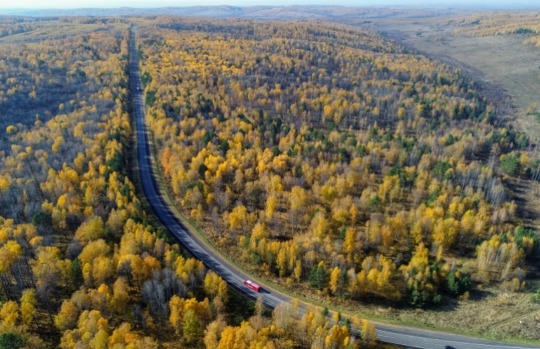
The taiga, the largest forest in the world, is home to Indigenous communities who have faced pressure from various development interests [File: Ilya Naymushin/Reuters]
Continued resistance
In its pursuit of resources and profits, the Kremlin and its business allies follow the logic of czarist-era colonisers whose conquest of Siberia, Alaska and a chunk of California (both sold to the United States in the 1800s) were driven by their quest for the fur of sables, foxes, ermines, otters and other animals, says Johannes Rohr, an expert on Indigenous affairs in Russia and project coordinator for the Institute for Ecology and Action Anthropology, a German NGO.
Known as “soft gold”, fur played a role in Russia’s exports and economy similar to today’s fossil fuels, he says. Cossacks, fur traders and czarist troops conquered Indigenous lands in ways that resemble the European colonisation of the Americas.
They crushed the resistance with firearms – while the Indigenous people had nothing but bows and arrows and spears. They imposed taxes on fur and introduced Orthodox Christianity – along with infectious diseases and alcoholism.
These days, the Kremlin sees any resistance to the development of resources on Indigenous lands as an existential threat, Rohr says.
“Back then, fur was collected from Indigenous peoples as tribute, and today, most oil is extracted in ancestral territories of Indigenous peoples. So, I guess, there is the idea that this [resistance] threatens Russia’s economic backbone,” says Rohr, who was barred in 2018 from visiting Russia for 50 years after a series of critical reports.
Communist Moscow gave Indigenous people university quotas and created collective cooperatives that specialised in fishing, hunting and animal husbandry that often destroyed traditional ways of life, annihilated property rights and restructured their communities.
They also purged or executed Indigenous elites such as shamans or wealthy reindeer owners, and the new elites were educated in “state-oriented” universities, Rohr says.
“Most of the Indigenous elites existing today, including the opposition-minded ones, are entirely state-oriented, their primary identity is that of Russian citizens, and there is no stable collective identity of Indigenous peoples” seen in countries like Peru or the US, Rohr says.
Despite this mindset, Indigenous activists confront the Kremlin in a David-versus-Goliath way – and some believe to improve the situation, Russia will have to live up to international standards of observing Indigenous rights.
“We will need to strive to build a system that will make possible the observation of Indigenous rights,” says Sulyandziga.
SOURCE: AL JAZEERA
#indigenous#indigenous russian#indigenous russia#russia#culture#important#colonization#nenet#turkic#Indigenous#landback#land back#Crimes#decolonize#fypシ#greenwashing
34 notes
·
View notes
Text

Reindeer, Murmansk, Russia, 1941 - by Yevgeny Khaldei (1917 - 1997), Ukrainian
275 notes
·
View notes
Photo

A lone reindeer in Murmansk, Russia stands still as fighter jets bombed nearby fields. World War II, 1941 [1600x1067] Check this blog!
37 notes
·
View notes
Photo

Reindeer sledge in the Russian North (Murmansk region), 1980
181 notes
·
View notes
Text
Arctic vs. Antarctic: how to pick your polar adventure
If you’ve ever dreamt about visiting one of the polar regions, use our guide to picking your Polar adventure: Arctic vs. Antarctic.
The North and South Poles were only “conquered” in relatively recent history. The South Pole was first set foot upon in 1911 by the Norwegian Roald Amundsen after his epic race with the ill-fated Scott. The conquest of the North Pole is a little murkier thanks to its location in the middle of the Arctic Ocean amid waters that are almost permanently covered with permanently shifting sea ice.
It’s possible that Frederick Cook was the first to reach the North Pole in 1908, or perhaps it was Robert Peary in 1911 or maybe Richard E. Byrd who was the first to fly over it in 1926… But it wasn’t until Roald Amundsen’s definitive flight over the Pole on 12th May 1926 that the first consistent, verified and scientifically convincing attainment of the North Pole was recorded.
Polar exploration has long sparked the public’s imagination and in recent years, travellers’ appetite for adventure means there is even more on offer than ever before.
Kia and I both dream of taking trips to the Polar circles – it’s just that we’re not sure when and where to go. (Well, that and the lack of funds…)
If you’ve ever dreamt about visiting one of these faraway destinations, use our guide to picking your Polar adventure: Arctic vs. Antarctic.
Temperature
Whether you head north or south you’re going to be cold. Very cold. However, it’s useful to know that unlike the rest of the planet, the south is colder than the north.
Broadly speaking, the Arctic region will experience temperatures between -43 and +5°C (-45 and 41°F) with coastal areas (which is where tourists are most likely to be) reaching +10°C (50°F) in the summer months. Average July temperatures range from about -10 to +10°C (14 to 50°F) with some inner land areas occasionally exceeding 30°C (86°F) in summer!
The Antarctic is a different story. It is the coldest continent on Earth. In 1983, researchers at the Soviet Antarctic station recorded the lowest natural temperature ever at ground level of -89.2°C (-128.6°F). Temperatures in Antarctica regularly reach -80°C (-112°F) in the interior in winter and between 5°C (41°F) and 15°C (59°F) near the coast in summer.
The Antarctic is considerably colder than the Arctic.
When to go
Winters and summers in the Polar regions are easier to define than in most destinations.
Put simply, the Arctic is closed from October to March thanks to much of the region being icebound, meaning ships cannot pass. The six-month darkness of the Polar night engulfs the region making sightseeing a rather tedious affair. Likewise, the Antarctic is closed from April to October due to freezing temperatures, the Polar night and pack ice reaching up to 1,000km beyond the edge of the continent.
Outside these timeframes, it largely depends on what you want to see and do and where exactly you want to go. For example, if you’re only interested in the bragging rights that come with crossing the Arctic Circle then this can be done year round in Scandinavia without leaving mainland Europe. At the other end of the world you’ll have to wait for the pack ice to break up between January and March to have a shot at crossing the Antarctic Circle.
The table below gives an idea of the best time to visit depending on your interests.
Best time for… Arctic Antarctic Largest icebergs Apr-Jun Nov-Jan Whales Apr-Sep Dec-Apr Humpback whales Apr-Jul – Narwhals Apr-Sep – Bird life Apr-Sep Dec-Mar Penguins – Dec-Feb Northwest passage accessible Jun-Aug – Ross Sea accessible – Jan-Feb Arctic circle crossing Year-round – Antarctic circle crossing – Jan-Mar North Pole expedition Feb-Apr – South Pole expedition – Nov-Jan Svalbard Jun-Aug – Greenland Apr-Sep – Falklands – Oct-Feb South Georgia – Oct-Jan Aurora watching Jan-Mar Mar-Sep
WildlifE
Even though the two Polar regions share many similar traits, they differ greatly in wildlife with a much wider range found in the north. This is because much of the landmass in the north is attached to continents that stretch further south while the Antarctic is completely isolated. This means the Arctic homes far more terrestrial mammals.
On land in the north you’ll find muskox, reindeer, caribou, foxes, hares, wolves, lemmings and of course, the polar bear. Marine mammals include seals, walruses, and several species of whale: humpback whales, baleen whales, narwhals, killer whales (orcas) and belugas.
youtube
In the south it’s slim pickings on land. The flightless midge, Belgica antarctica, is just 6mm (0.25in) in size and is the largest purely terrestrial animal in Antarctica. In the water there’s more to see with several species of penguin including Emperor, Adélie, Rockhopper, King, Chinstrap and Gentoo penguins all living in the Antarctic peninsular. Additionally, there are blue whales, killer whales, colossal squids and fur seals.
ADVENTURE
If you want to see how you measure up against the great Polar explorers of the past then here are a few of the best options available.
COMFORT
It’s unfair to call those unmoved by the above unadventurous – surely travelling to the Polar Regions is adventurous by definition. However, if you would prefer a little more comfort then there are plenty of cruise and activity holidays available which won’t leave your loved ones biting their nails until your safe return.
I have my eyes on the Arctic Circle Trail in Greenland as well as a trip to Tromsø in Norway to see the northern lights after our failed attempt to catch them in Iceland several years ago. Quark Expeditions offer a range of cruise-based holidays in the Polar regions.
The Arctic Circle Trail follows a course through an area known as the “land of one hundred lakes” (Image: Visit Greenland, Limited Commercial License)
Northern vs. Southern lights
One of the most stunning natural phenomena in the world are the Aurora Borealis and Aurora Australis, more commonly known as the Northern and Southern Lights. Unless you’re a Norwegian astronomer there really is little difference between the northern lights and the Southern Lights other than geographical location. They both take place over the Polar regions and are basically the same phenomenon.
That said, the northern lights are far more accessible. They can be viewed from Iceland, Finland, Norway, Sweden, Denmark, Scotland, Russia, Greenland, Canada and Alaska. Outside of continental Antarctica, the Southern Lights can only be seen from southernmost New Zealand, Argentina and Australia.
Culture
Arctic nations include Canada, Greenland (a territory of Denmark), Russia, United States (Alaska), Iceland, Norway, Sweden, and Finland. Within these nations, around four million people live within the Arctic Circle. Unlike the Antarctic, the Arctic has an indigenous population stretching back thousands of years.
The Inuit people inhabit the Arctic regions of Greenland, Canada, and Alaska, while other Circumpolar North indigenous peoples include the Buryat, Chukchi, Evenks, Inupiat, Khanty, Koryaks, Nenets, Sami, Yukaghir and Yupik. There are also industrialised cities within the Arctic Circle. The four largest communities within are in Russia and Norway: Murmansk (population 307,257), Norilsk (175,365), Tromsø (71,590) and Vorkuta (70,548).
Nenet woman among reindeer, Yamal Peninsula in Siberia © Lexi Novitske
In the Antarctic, there is no indigenous population. There are zero permanent inhabitants but there are numerous research stations set up across the continent. In the summer as many as 5,000 people reside in the Antarctic but this drops to around 1,000 in the winter. You won’t be visiting any craft markets here!
Cost
Simply put, Polar travel is expensive. You will be visiting the most inhospitable regions on the planet where life is hard. The Arctic Circle is far more popular due to its accessibility and the fact that travel is cheaper there. That said, some of the most expensive countries in the world (Norway, Sweden, Finland, Russia) are located along and within the Arctic Circle, making even the cheapest Polar weekend break an expensive affair.
The Antarctic is without doubt more expensive than its northern sibling. It is further away from transport hubs, there is no permanent accommodation available and life is simply harder further south. For an easy comparison of costs, a 13-day Arctic cruise and flight with Quark costs $7,995. In comparison, a similar 10-day Antarctic cruise and flight will set you back $11,595 – considerably more for considerably less.
Likewise, at the expedition end of the scale, Adventure Consultants’ North Pole – Ski the Last Degree trip (15-19 days) starts at $42,000 while the equivalent South Pole – Ski the Last Degree trip (15 days) costs $62,500.
Arctic vs. Antarctic
Polar travel like most forms of travel is on the rise. It is almost impossible to verify how many people visit the Arctic but during the 2009-2010 tourist season, over 37,000 people visited Antarctica – twice the estimated 14,000 that visited in the 1999-2000 season 10 years before. One assumes that this figure will continue to double every 10 years although I doubt (and hope) the Antarctic or the harder-to-reach areas of the Arctic will ever compete with Thailand or other popular destinations.
For me, the Antarctic is the very definition of adventure. The very mention of its name evokes tales of against-the-odds survival and iconic names such as Amundsen, Shackleton and Scott. I dream of completing the seven summits which means that one day I will have to climb Vinson Massif in Antarctica – an ambition I look forward to with both boyish enthusiasm and wary trepidation.
The South Pole was first set foot upon in 1911 by the Norwegion Roald Amundsen
Kia and I were in Tierra del Fuego last year but at the wrong time for a trip to Earth’s southernmost continent. We will just have to go back one day…
Maybe it’s because we live in Europe but the Arctic simply doesn’t have the same allure as the Antarctic. Sure, we want to visit Greenland, trek the Arctic Circle Trail, see the northern lights and cross the Arctic Circle. But considering many of these are just a (relatively) short plane ride away, it just doesn’t have the same end-of-the-Earth appeal.
For me, the Antarctic still grabs all the headlines.
G Adventures are the largest small-group adventure travel company in the world with over 650 small group adventures to choose from and offer a range of Antarctica cruises.
(function(d, s, id) var js, fjs = d.getElementsByTagName(s)[0]; if (d.getElementById(id)) return; js = d.createElement(s); js.id = id; js.src = "http://connect.facebook.net/en_US/sdk.js#xfbml=1&appId=696667793712621&version=v2.3"; fjs.parentNode.insertBefore(js, fjs); (document, 'script', 'facebook-jssdk'));
from Cheapr Travels https://ift.tt/2J7i5JW via https://ift.tt/2NIqXKN
5 notes
·
View notes
Photo

Reindeer in Murmansk, 1941 via reddit https://ift.tt/2TlUDzP
13 notes
·
View notes
Photo


Kola Peninsula, Céline Clanet
#reindeer herding#sami people#russia#murmansk oblast#french photography#russian photography#animals#night sky#purple aesthetic#my post#post soviet#trains#winter aesthetic
67 notes
·
View notes
